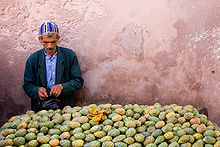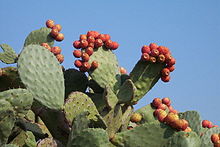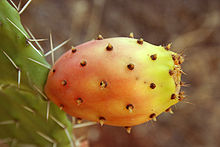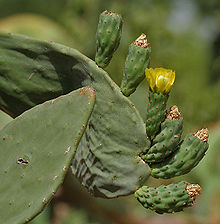- Opuntia ficus-indica
-
Opuntia ficus-indica 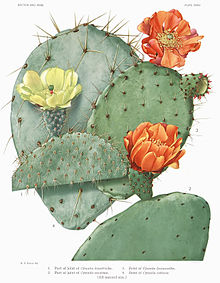
Illustration by Eaton in The Cactaceae Scientific classification Kingdom: Plantae (unranked): Angiosperms (unranked): Eudicots (unranked): Core eudicots Order: Caryophyllales Family: Cactaceae Genus: Opuntia Subgenus: Opuntia Species: O. ficus-indica Binomial name Opuntia ficus-indica
(L.) Mill.Synonyms[1] - Cactus decumanus Willd.
- Cactus ficus-indica L.
- Opuntia amyclaea Ten.
- Opuntia cordobensis Speg.
- Opuntia decumana (Willd.) Haw.
- Opuntia gymnocarpa F. A. C. Weber
- Opuntia hispanica Griffiths
- Opuntia maxima Mill.
- Opuntia megacantha Salm-Dyck
- Opuntia paraguayensis K. Schum.
Opuntia ficus-indica is a species of cactus that has long been a domesticated crop plant important in agricultural economies throughout arid and semiarid parts of the world. It is thought to possibly be native to Mexico.[1] Some of the common English names for the plant and its fruit are Indian fig opuntia, barbary fig, and prickly pear, although this last name has also been applied to other less common Opuntia species.
Contents
Growth
Fig opuntia is grown primarily as a fruit crop, but also for the vegetable nopales and other uses. Most culinary references to the "prickly pear" are referring to this species. The name "tuna" is also used for the fruit of this cactus, and for Opuntia in general (according to Alexander von Humboldt, it was a word of Hispaniola native origin taken into the Spanish language around 1500 CE.[2])
Cacti are good crops for dry areas because they efficiently convert water into biomass. O. ficus-indica, as the most widespread of the long-domesticated cactuses, is as economically important as corn and tequila agave in Mexico today. Because Opuntia species hybridize easily (much like oaks), the wild origin of O. ficus-indica is likely to have been Mexico due to the fact that its close genetic relatives are found in central Mexico.[3]
Uses
The most commercially valuable use for Opuntia ficus-indica today is for the large, sweet fruits, called tunas. Areas with significant tuna-growing cultivation include Mexico, Spain, Sicily and the coasts of Southern Italy, Greece, Tunisia, Morocco, Algeria, Egypt, Saudi Arabia,[Yemen] Israel, Chile, Brazil, Turkey, as well as in Eritrea and Ethiopia where the fruit is called beles (Ge'ez: በለስ).[4] In Sicily, where the prickly pear fruit is known as ficodinnia (the Italian name being fico d'India), the cactus grows wild and cultivated to heights of 12-16 feet (4-5 meters).
The plants flower in three distinct colors: white, yellow and red. The flowers first appear in early May through the early summer in the Northern Hemisphere, and the fruit ripen from August through October. The fruit are typically eaten, minus the thick outer skin, after chilling in a refrigerator for a few hours. They have a taste similar to a juicy, extra sweet watermelon. The bright red/purple or white/yellowish flesh contains many tiny hard seeds that are usually swallowed, but should be avoided by those who have problems digesting seeds.
Jams and jellies are produced from the fruit, which resemble strawberries and figs in color and flavor.
Mexicans have used Opuntia for thousands of years to make an alcoholic drink called colonche.
In the center of Sicily, in the Province of Enna, in a small village named Gagliano Castelferrato, a prickly pear-flavored liqueur is produced called "Ficodi", flavored somewhat like a medicinal/aperitif.
In the early 1900s in the United States, the prickly pear fruit was imported from Mexico and Mediterranean countries to satisfy the growing population of immigrants arriving from Italy and Greece. The fruit lost its popularity during the mid 1950's, but has increased in popularity since the late 1990s, due to the influx of Mexican immigrants.
Recently, the cattle industry of the Southwest United States has begun to cultivate O. ficus-indica as a fresh source of feed for cattle. The cactus is grown both as a feed source and a boundary fence. Cattle avoid the sharp spines of the cactus and do not stray from an area enclosed by it. Native prickly pear growth has been used for over a century to feed them; the spines can be burned off to reduce mouth injury. The cactus pads, on which the cattle feed, are low in dry matter and crude protein, but are useful as a supplement in drought conditions.[5]. In addition to the food value, the moisture content virtually eliminates watering the cattle and the human effort in achieving that chore.
Mexican and other southwestern residents eat the young cactus pads (nopales, plural) (nopal, singular), usually picked before the spines harden. They are sliced into strips, skinned or unskinned, and fried with eggs and jalapeños, served as a breakfast treat. They have a texture and flavor like string beans.
In Malta, a liqueur called Bajtra (the Maltese name for prickly pear) is made from this fruit, which can be found growing wild in most every field. On the island of Saint Helena, the prickly pear also gives its name to locally distilled liqueur, Tungi Spirit.
Other uses include as an ingredient in adobe (to bind and waterproof).[3]
Opuntia ficus-indica (as well as other species in Opuntia and Nopalea) is cultivated in nopalries to serve as a host plant for cochineal insects, which produce desirable red and purple dyes. This practice dates from pre-Columbian times.[6]
The plant is considered a pest species in parts of the Mediterranean Basin due to its ability to spread rapidly beyond the zones it was originally cultivated. In Hebrew, the plant is referred to as "sabres."[7] Kishkashta, a main character on a 1970-80s Israeli children's show, "Ma Pit'om", was a large, talking felt puppet of the Opuntia cactus.
Opuntia ficus indica is used as a dietary supplement to decrease oxidative stress and lower blood lipid levels in healthy humans.
The high levels of Selenium in Opuntia are comparable to those found in Brassicaceae[8]
The fruit of Opuntia ficus-indica can cause constipation if consumed with the seeds, without the seeds it is laxative.[9]
Biogeography
Recent DNA analysis indicated O. ficus-indica was domesticated from Opuntia species native to central Mexico. The Codex Mendoza, and other early sources, show Opuntia cladodes, as well as cochineal dye (which needs cultivated Opuntia), in Aztec tribute rolls. The plant spread to many parts of the Americas in pre-Columbian times, and since Columbus, have spread to many parts of the world, especially the Mediterranean, where they have become naturalized (and in fact were believed to be native by many). This spread was facilitated by the carrying of nopales on ships to prevent scurvy.[3]
Sources
- Anderson, E. F. 2001. The cactus family. Timber Press, Portland, Oregon, USA.
- Benson, L. H. 1982. The cacti of the United States and Canada. Stanford University Press, Stanford, California, USA.
- Donkin, R. 1977. Spanish red: an ethnogeographical study of cochineal and the Opuntia cactus. Transactions of the American Philosophical Society 67: 1–77.
- Griffith, M. P. 2004. The origins of an important cactus crop, Opuntia ficus-indica (Cactaceae): New molecular evidence. American Journal of Botany 91: 1915-1921.
- Kiesling, R. 1998. Origen, domesticación y distribución de Opuntia ficus-indica. Journal of the Professional Association for Cactus Development 3. Available online.
References
- ^ a b USDA GRIN
- ^ Baron F. H. A. von Humboldt's personal narrative of travels to the equinoctial regions of America tr. 1852 by Ross, Thomasina: "The following are Haytian words, in their real form, which have passed into the Castilian language since the end of the 15th century... Tuna". Quoted in OED 2nd ed.
- ^ a b c Griffith, 2004
- ^ "Beles" in Encyclopaedia Aethiopica: A-C(Wiesbaden:Harrassowitz Verlag, 2003).
- ^ http://agfacts.tamu.edu/D11/Extension/animal%20science/Prickly1.htm
- ^ Keisling, 1998
- ^ This led to the popular use of the term "Sabra" to refer to an Israeli-born Jew, alluding to the fruit and the people alike being tenacious and thorny (rough and masculine) on the outside but sweet and soft (delicate and sensitive) on the inside.
- ^ Bañuelos GS, Fakra SC, Walse SS, Marcus MA, Yang SI, Pickering IJ, Pilon-Smits EA, Freeman JL. "Selenium accumulation, distribution, and speciation in spineless prickly pear cactus: a drought- and salt-tolerant, selenium-enriched nutraceutical fruit crop for biofortified foods." Plant Physiol. 2011 Jan;155(1):315-27 http://www.ncbi.nlm.nih.gov/pmc/articles/PMC3075757/?tool=pubmed
- ^ J Ethnobiol Ethnomedicine. 2007; 3: 15. Published online 2007 March 30. doi: 10.1186/1746-4269-3-15 http://www.ncbi.nlm.nih.gov/pmc/articles/PMC1858679/
Categories:- Opuntia
- Cacti of Mexico
- North American desert flora
- Medicinal plants
- Natural history of Mesoamerica
- Desert fruit
- Energy crops
- Crops originating from Mexico
- Crops originating from the Americas
- Garden plants of North America
Wikimedia Foundation. 2010.



